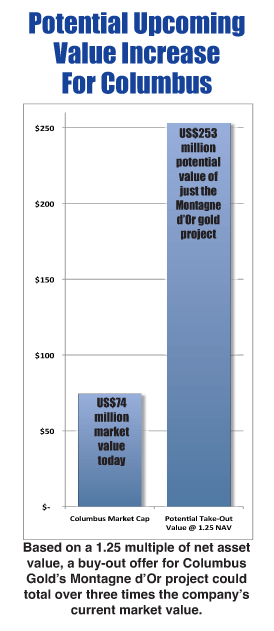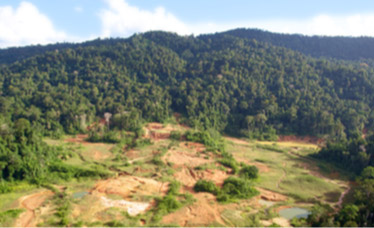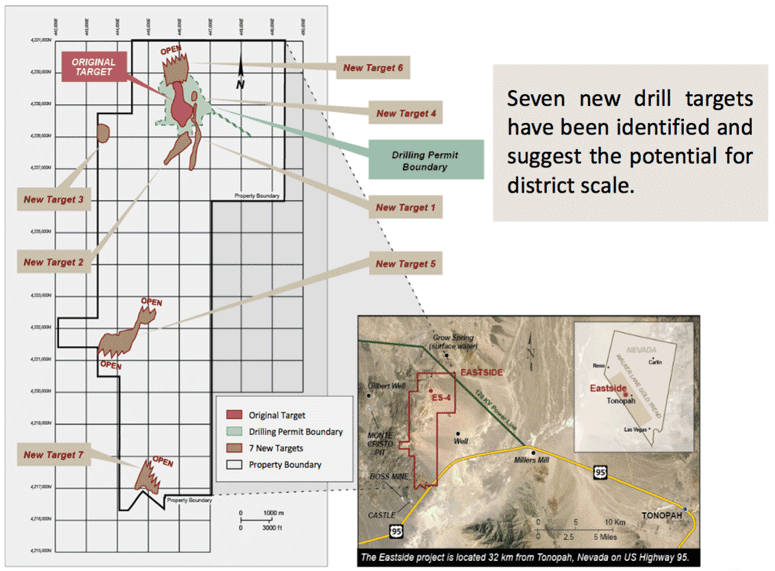
The Perfect Gold Play?
The perfect gold play — if you could find it — would combine
relatively low risk with the potential for exceptionally high rewards.
Measured by those criteria, it’s hard to imagine a better gold
investment than Columbus Gold (CGT.V; CBGDF.OTCQX).
By Brien Lundin
Upcoming developments are
There are many ways for Columbus Gold to climb to a far higher market valuation. Importantly for those who can buy the stock now, all of these factors are now working together. Consider that the release of the eagerly-awaited feasibility study for Montagne d’Or stands to launch the bidding process by Nordgold. Right now, Columbus Gold is being valued at about half of the net asset value projected by the preliminary economic assessment for the project. Recent buyouts of other companies have come in between 1.0-1.25x NAV. That implies about a doubling of Columbus’ market cap if Nordgold comes in with a bid at just market averages. But the price could be much higher if other bidders arise for the whole company…if the upcoming resource estimate for the Eastside project in Nevada surprises the market…and if Eastside is spun out to shareholders as a valuable added bonus. All of these factors are in play, and will come to the fore over the weeks directly ahead. The timing, in short, couldn’t be better. |
 afety and profits.
afety and profits.
Those two words don’t go together often in the investment world. To realize big gains, you usually have to accept higher risk.
I say “usually,” because, every now and then, the world of junior resource stocks presents investors with the opportunity to make fortunes, while keeping their downside well protected.
Such is the case with Columbus Gold, a junior mining company that’s quickly moving toward a big inflection point in its valuation — one that not only seems inevitable, but which has also been completely paid for by a major mining company.
Indeed, much of the risk of investing in Columbus has already been wrung out of the company. An investment in Columbus is an investment in …
![]()
- A rich, five-million-ounce gold resource that’s ripe for acquisition…
- A clear and rapid path toward production and the rich cash flow that it would provide...
- A looming potential buy-out by its joint venture partner — which few investors are yet aware of — that could send the share price leaping higher…
- Two key trigger points…on two separate projects…that could soon lead to a share-price re-rating…
- The potential for a bidding war for the entire company as a whole — another event could quickly lead to out-sized gains for today’s shareholders…
- A gold exploration project in Nevada — which the market is almost entirely overlooking — that could soon deliver a blockbuster surprise…
![]()
Sure, Columbus Gold has surged ahead along with the rest of the gold market this year, but its true potential has been held back by the perceived “lack of mystery” about who will eventually buy its share of Montagne d’Or, the company’s flagship project.
But, as I’ve already hinted at, that buyer (Nordgold), is just one of several that I predict will emerge with the right confluence of events.
As you’re about to see, I think those events have the potential to happen nearly simultaneously — setting off a bidding war for Columbus’ large share of a big gold project — right after long-awaited release of a feasibility study on that project.
And that news is coming sooner than many believe.
Adding to the drama is a potential resource estimate on its Nevada gold project that the market isn’t even factoring into the company’s current valuation. And that report, too, could drop not long before the feasibility study on Montagne d’Or hits the market.
It’s all a recipe for a bidding war that could multiply the company’s current share price several times over.
And regardless of how heated that bidding war is…or even if it happens at all…the likelihood of an offer from Columbus’ current partner at a substantial premium means we enjoy both the potential of windfall profits and the security of a proven, world-class gold resource.
A Fast-Approaching Trigger
There are certain points along the path to production where a company’s valuation tends to be optimal.
It begins with the discovery phase, that point at which drilling results indicate a company has identified a significant new deposit.
The valuation usually steadily increases as confidence in the deposit’s size, continuity and mineability increase. This de-risking phase is vitally important, and typically peaks with the release of a feasibility study.
This is no easy task — a feasibility study requires significant financial and engineering resources and involves a host of studies to determine a project’s suitability as a mine.
But having a bankable feasibility study in hand allows companies to secure the financing needed to begin actual mine construction. As such, it is a pivotal point in the life-cycle of any mining project.
The good news for investors in Columbus Gold is that this key point is fast approaching.
Thanks to the highly favorable joint venture deal it has secured with Nordgold, Columbus is now about the reach the feasibility stage on its Montagne d’Or deposit in French Guiana.
I’ll have more on the company’s deal with Nordgold in a minute, but for now it’s enough to know that Nordgold is financing the feasibility stage at Montagne d’Or and will earn a 55.01% stake once that study is complete.
And that’s why the timing of this opportunity is so exciting.
You see, the feasibility study on the Montagne d’Or deposit project is due very early next year. Right now, the market has yet to appreciate how close this pivot point for Columbus is. But rest assured, the speculation will begin in earnest as the date approaches.
So now is the ideal time to build a position in Columbus Gold.
That’s because once Nordgold releases the feasibility study and officially earns its stake in Montagne d’Or, it will be the perfect time for the two companies to begin negotiating for the part of the project that Columbus Gold will retain.
The most obvious scenario at that point will be for Nordgold to buy Columbus Gold out. If that happens, a previously negotiated agreement ensures that Columbus will get a good price for its share of the project — one that will could be two or three times the company’s current market cap.
But here’s another possibility: Columbus could field other offers for the company, thereby raising its ultimate return to investors still further.
Regardless of how it plays out, the deal with Nordgold protects shareholders’ downside risk while, at the same time, offering tremendous upside profit potential.
That’s why Columbus Gold offers that rare combination of both safety and profit potential, regardless of what happens with gold.
But the fact is, the value offered by Columbus Gold right now could grow considerably as gold continues its next big bull run.
The Irrefutable
Case for Gold
After wandering in the wilderness of a bear market for nearly four years, gold has rocketed ahead this year, gaining more than $200 from the lows it posted in early January.
And this new bull run in the yellow metal has powered gold equities even further, with companies recommended by our sister publication, Gold Newsletter, doubling, tripling and even quadrupling in price.
One of our top picks has soared over six times in value.
The reason for the renewed interest in gold is clear. Having accumulated mountains of debt, nations across the world are busily building mountains of money to dilute away the value of those debts.
They’re also trying to spark their moribund economies by buying everything in sight — from government debt to corporate debt and, now, even looking to buy corporate equities!
And they’ve embarked on the truly unprecedented experiment of negative interest rates.
The intended effect of charging people rent for their money instead of paying interest is to force them to spend their cash instead of saving it.
The unintended effect of this policy is to send investors and savers across the world scurrying to buy gold.
And yet, economic growth remains stuck in the mud, not only in Europe and many developing nations, but also in the U.S. Even the Federal Reserve has been forced to consider negative interest rates if things get much worse for the U.S. economy.
Consider this: The lowest interest rates in 5,000 years of human history are, alone, more than enough to keep the gold bull galloping ahead.
But if the U.S. economy continues to teeter…if/when it slides into its long-overdue recession…the Federal Reserve will be forced to relaunch its quantitative easing.
And there’s no doubt that gold would absolutely explode higher when that happens.
That’s why the Fed is so desperate to somehow get one or two rate hikes under its belt — so it has room to cut when the economy eventually takes a dive.
But with inflation running in the 1.5%-2.0% range, depending upon which gauge you use, the Fed could hike rates every quarter and we’d still have negative rates after adjusting for inflation for around two years!
That means there’s plenty of runway left on this gold bull run. And we’re only one or two bad economic reports away from a return to QE that would send the bull market into overdrive.
From our perspective, the current environment gives us the perfect time to invest in an undervalued gold play like Columbus Gold.
A “Mountain of Gold”
Named “Montagne d’Or” or “Mountain of Gold” by locals, this deposit more than earned its name with a multi-million-ounce hoard of the yellow metal that is amenable to low-cost open-pit mining techniques.
 Years of drilling have established a large deposit with grades that put it in the sweet spot for open-pit development.
Years of drilling have established a large deposit with grades that put it in the sweet spot for open-pit development.
The known deposit at Montagne d’Or spans 2,500 meters in strike and has been drilled to a vertical depth of 250 meters. The potential ore here lies within a hill, which means a future miner will have the benefit of gravity to help it with extraction.
The indicated resource stands at 3.89 million ounces of gold (83.2 million tonnes of 1.45 g/t) and the inferred resource includes 1.11 million ounces of gold (22.4 million tonnes of 1.55 g/t).
The deposit’s ore has already undergone metallurgical testing. The ore types of both the primary Upper Felsic Zone (“UFZ”) and the Lower Favorable Zone (“LFZ”) have demonstrated high recoveries between 95% and 97%.
Open-pittable deposits of this size, with recoveries this good, are difficult to come by. Simply put, mid-tier and major gold producers are always on the hunt to grow their reserve production bases with deposits of exactly this type.
(And — as you’re about to see — it looks like the deposit could get much, much larger.)
From an investment perspective, there’s real safety in a deposit of Montagne d’Or’s quality. The value in the ground is already well established, and will only become more so as Nordgold finishes up on the current US$30 million development program to bring the deposit to feasibility.
When that key step is finalized, I expect a re-rating of Columbus’ share price to ensue, as investors realize that the company is trading well below the going rate for a deposit like this.
Compelling Economics
A preliminary economic estimate on Montagne d’Or released in July 2015 revealed a world-class gold mine in the making.
Using a 5% discount rate and a gold price of $1,200 (almost $100 below current trading levels), the project has an after-tax NPV of $450 million. Its after-tax internal rate of return is 23%, and its initial capex ($366 million) is imminently financeable in the current market.
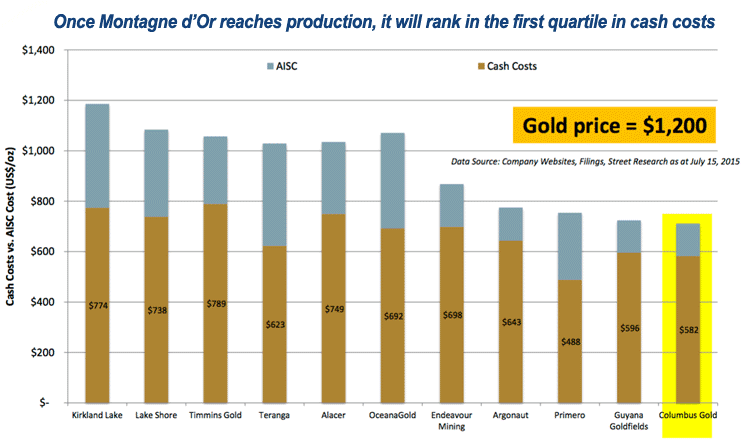
The mine would have all-in sustaining costs of just $711, which would put it on the low end of current producers around the world. Annual gold production for the first 10 years of a planned 13-year mine life would average 273,000 ounces.
Recent deals for companies with comparable assets have been done for in the neighborhood of a 1.0-1.25 price/net-asset-value price.
After Nordgold completes its feasibility study, Columbus will own 44.99% of the project. Using the PEA numbers, that would mean it would lay claim to around $200 million of Montagne d’Or’s projected value. With a current market cap of around C$100 million, a sale of the company (and the project) could result in a more-than-doubling of Columbus’ current share price.
And that’s before considering the tremendous growth potential of the deposit…or Columbus’ other high-potential properties.
It’s an enviable position for a junior gold company. But it’s not by accident —the Columbus management team put the company in this position through clever negotiations years ago.
The Value of the Nordgold Deal
When Nordgold decided to help Columbus Gold take Montagne d’Or through feasibility, it was a major endorsement of the project’s development prospects as a gold mine.
A major world gold producer, Nordgold had 2015 revenues of $1.1 billion dollars. The company operates nine gold mines in four countries and produced 950,000 ounces of gold last year.
Excitingly for Montagne d’Or’s development prospects, Nordgold has a reputation for getting projects into production. In fact, it built the Bissa Mine in Burkina Faso, a 200,000-ounce-per-year operation, in just 15 months.
The deal for Montagne d’Or calls for Nordgold to spend a minimum of $30 million on the project by March 2017. Moreover, to earn its 55.01% share, the company must complete the aforementioned feasibility study.
As it approaches that milestone, the partnership with Nordgold has put Columbus in extremely good position. Because it hasn’t had to finance the most expensive part of the exploration and development process at Montagne d’Or, it has been able to keep a lid on the dilution of its share structure and it has been able to spend money exploring its Eastside project in Nevada (more on it in a minute).
The impending feasibility study will create an inflection point for the project and for Columbus generally.
Combined with the continued resurgence of the gold market — and a couple of special factors that I’ll discuss shortly — this could light a fuse under Columbus’ share price.
A Safe, Stable
Mining Jurisdiction
In the game of mine development, political risk is nothing to take lightly.
The industry is filled with stories of companies that found and developed potentially lucrative mines, only to have those assets stripped away by corrupt government officials or worse, expropriated wholesale, leaving investors holding the bag.
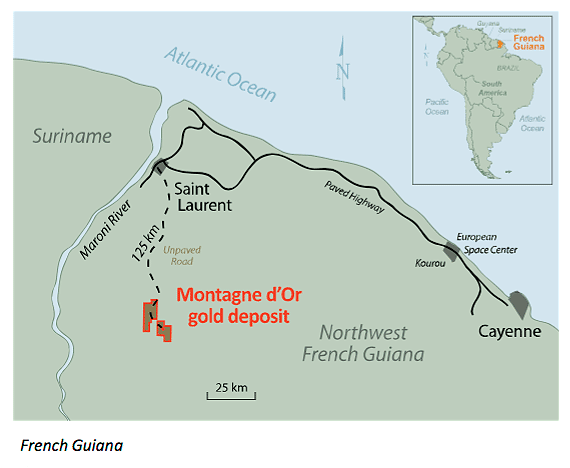 So it’s no small matter that French Guiana, as one of the 27 regions of France, is thus governed by the rule of law and is a very favorable climate for mining. Investors can get behind a project like Montagne d’Or with full confidence that their money won’t disappear at the whim of a government on a nationalization binge.
So it’s no small matter that French Guiana, as one of the 27 regions of France, is thus governed by the rule of law and is a very favorable climate for mining. Investors can get behind a project like Montagne d’Or with full confidence that their money won’t disappear at the whim of a government on a nationalization binge.
Such is the value of the rule of law and a reliable legal system. Companies that do business in French Guiana can rest assured that their claims will be treated fairly and that they can share development success with the investors who made it possible.
Better still, the country has become even more mining friendly in recent years. In 2012, it passed legislation defining where open pit mining is authorized. That legislation definitively allows Montagne d’Or to be developed as an open-pit mine.
Moreover, mother country France has been making moves to grease the wheels for mining projects. In 2013, the country granted exploration licenses in mainland France for the first time in more than two decades.
And, just in the past several months, the state royalty has been reduced and a gold producer has received authorization to build a cyanide plant in the country.
Looking ahead, France is working on making its mining code more streamlined so that permitting is easier. Clearly, the French government is seeing the global scramble for commodities like gold and wants to ensure that it remains a player on that front.
French Guiana itself has a long history of gold production. The yellow metal was first discovered there in 1854 and, due mainly to its relatively tiny population, it is currently the world’s highest per capita gold producer.
In fact, the rivers and streams running through Columbus’ project have generated more than two million ounces of recorded gold production since 1875! What was actually mined and not recorded is likely much more.
Now, Columbus and Nordgold are taking advantage of the favorable mining environment and a world-class gold deposit to put this region on the map, not just as an alluvial gold destination, but a significant section of an underdeveloped greenstone belt.
The Obvious Buyer
Because of the unique attributes and growth potential of the Montagne d’Or deposit, Columbus was able to strike a truly innovative deal with Nordgold that gives the junior a growing stake as the size of the resource grows.
Importantly, it’s a stake that Nordgold can’t dilute away by out-spending the junior company.
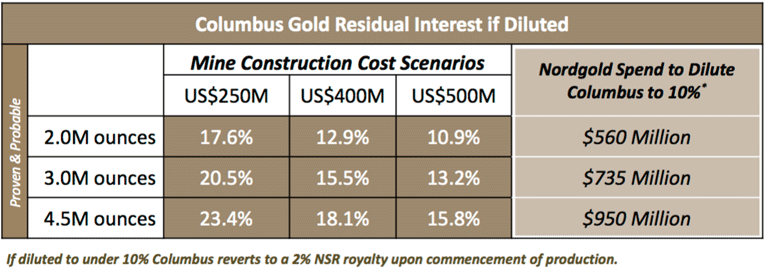
The accompanying chart demonstrates how lucrative the deal could be for Columbus and its shareholders. It assumes that, rather than contributing its share of the expense of building the mine, Columbus elects to let Nordgold shoulder that burden.
Situated between Brazil and the tiny country of Suriname, French Guiana has a lot to offer as a mining destination. It boasts 35,000 square kilometers (13,500 square miles) of highly prospective “greenstone” geology within the Guiana Shield that runs along the northern coast of South America. The Guiana Shield is the Western Hemisphere’s analog to the Birimian Shield that makes West Africa such a gold mining hotbed. Columbus Gold’s Montagne d’Or project lies within one of the greenstone sections of the Guiana Shield, which in recent years has yielded impressive gold deposits like Las Cristinas in Venezuela (27.1 million ounces) and Toroparu in Guyana (10.0 million ounces). Gold was first discovered in French Guiana in 1854, and the alluvial gold production that led to the discovery of the Montagne d’Or project has generated more than 2 million ounces of gold since 1875. As one of the 27 regions of France, French Guiana offers investors security of ownership and a reliable legal system where the rule of law is respected. Corruption levels are very low. Both French Guiana and France are moving to make the country even more hospitable to mining interests. In 2012, legislation was passed defining areas where open-pit mining is permissible (the area surrounding Montagne d’Or is one of those areas.) In 2013, France granted exploration licenses to interests in that country for the first time in more than two decades. And in 2014, we saw a reduction in the state royalty and the issuance of a permit for a cyanide plant. Given these developments in French Guiana’s mining policy, the impending completion of a feasibility study on Montagne d’Or is extremely well-timed and the project’s location in French Guiana makes it likely that it will get the permits its needs to green light production. |
As you can see, the deal has the potential to be a good one for Columbus, with the amount of proven and probable ounces of gold in the feasibility report dictating the company’s rate of dilution. The rate is also impacted by the cost of mine construction at Montagne d’Or.
For a two-million-ounce scenario, Columbus would maintain a 17.6% interest in Montagne d’Or for a mine with a $250 million capex. It would retain a 12.9% interest if the mine costs $400 million to build and a 10.9% interest if it cost $500 million to build. To dilute Columbus to 10%, Nordgold would have to spend $560 million on the project.
Assuming the feasibility study generates three million ounces of proven and probable gold, that interest jumps to 20.5% for a $250 million capex, 15.5% for a $400 million capex and 13.2% for a $500 million capex. Nordgold would have to spend $735 million to dilute Columbus’ share of the project to 10%.
Finally, at a 4.5-million-ounce level for proven and probable resources, Columbus’ diluted share is 23.4% for a $250 million mine, 18.1% for a $400 million mine and 15.8% for a $500 million mine. Nordgold would have to spend more $950 million to dilute Columbus to a 10% share.
At any level of dilution below 10%, Columbus’ share reverts to a 2% net smelter royalty upon commencement of production.
Thus, Columbus’s deal guarantees the company a very significant stake in the mine even if it does nothing at all.
The Possibility of
Other Bidders
At first blush, it might seem like Columbus Gold is locked into having Nordgold buy it out. But that’s only the case if any other bidders that emerge for Montagne d’Or only bid for the deposit itself. In that scenario, Nordgold has the right of first refusal on any offer made on the deposit.
But here’s the key: There’s nothing preventing a potential suitor from making an offer for Columbus Gold as a whole.
In fact, as you’ll see shortly, Columbus has an underappreciated exploration project in Nevada that has the potential to justify the company’s current market value all by itself.
As I’ve already said, Columbus, while up strongly this year, has generally underperformed its peer group. Essentially, the market has shrugged its shoulders at Columbus Gold and Montagne d’Or, convinced that the there’s no mystery as to who the bidder will be for the project or the company.
Everyone knows that Nordgold is almost assuredly going to bid for the company’s interest in Montagne d’Or. Their track record shows that they’ve done this with all of their junior partners, paying a premium to their then-current market value.
But investors are not…yet…assigning a premium to Columbus for a potential bidding war.
But I think other bidders are likely to emerge, making the buyout price for Nordgold significantly richer than the market is currently anticipating.
That’s especially true when you realize that Montagne d’Or has significant expansion potential — and Columbus Gold has the option of testing that potential.

|
Opportunities For Growth
There’s a lot of solid geological evidence indicating that Montagne d’Or can grow quite significantly.
First of all, soil sampling shows that the gold-in-soil anomaly hosting the known deposit extends along strike to the east and west for a total of five kilometers. That’s fully double the size of the deposit’s current 2.5-kilometer strike length.
To this geochemical evidence Columbus can add geophysical evidence, thanks to a high-tech electromagnetic survey that can penetrate the ground. Specifically, the induced polarization anomaly that outlined the original deposit extends east and west for more than another mile.
Taken separately, geochemical and geophysical anomalies can be good first indicators of a deposit. But when you combine them on top of each other in an area already known to host gold, the prospect of further discoveries becomes very real.
That becomes even more true when you consider that the geological composition of the mineralization to the east and west of the deposit extends for 1.6 miles. When you have one indicator, that’s good. When you have two indicators that’s even better.
But when all three of these indicators for potential growth come together, you have the very real potential that this deposit could be much, much bigger.
And, as if the lateral and infill growth possibilities weren’t tantalizing enough, the deposit also has the potential to grow at depth.
Both zones at Montagne d’Or have only been drilled to an average of 250 meters in depth. And yet many of the holes that have defined those zones either bottomed in mineralization or have otherwise indicated that the mineralization could extend to depths well below 250 meters.
And finally, there’s potentially significant mineralization above the currently defined resources. Experienced gold stock investors know that much of the gold mined in this area of the world is found in the highly eroded “saprolite” layer close to the surface.
However, almost all of the drilling at Montagne d’Or has been done at an angle, away from the top of the zones, to get cross-sections of the zones at depth.
Thus, these holes have completely bypassed the saprolite layer above the zones. This is potentially rich pay dirt that could add tremendously to the size of the resource and the profitability of the mine.
In short, in advance of Nordgold’s feasibility study on Montagne d’Or, Columbus Gold has an opportunity to substantially increase the project’s value (and the value of Columbus as whole).
More Golden Upside In Nevada
Doing so will make the prospect of a whole-company takeout that much more tangible. And that’s before you factor in the exciting project it is actively exploring in Nevada.
If you were going to pick a spot to look for gold, you’d be hard pressed to find a better place than Nevada.
The political stability and mining friendly nature of the state are just the table stakes for what is truly one of the world’s great gold mining destinations.
A recent snapshot of the state’s gold production gives you a sense of the place. In 2013, the state produced 5.44 million ounces of the yellow metal, an amount which accounted for more than 6% of the world’s output and 75% of U.S. output.
The state’s mines have produced more than 169 million ounces of gold to date, and yet it still has 70 million ounces of gold remaining in reserves. This is a land of elephant-sized deposits, where gold finds of over 10 million ounces are possible.
Eastside Resource Could Grow Significantly
|
Columbus made a strong move to add to the state’s rich mining history when it enlisted the help of Cordex Partners. This group has a more than 35-year track record exploring for gold in the state and ranks among Nevada’s most successful mine-finders.
Indeed, Cordex was founded by John Livermore, the man responsible for the discovery of the Carlin Mine. That discovery in the early mid-1960s set the stage for an explosion in Nevada mining activity and production. Andy Wallace joined Livermore in 1974, and as a team added other multi-million-ounce discoveries to Cordex’s credit, including the Stonehouse/Lone Tree, Marigold, Daisy, Pinson, Florida Canyon, Dee, Sterling, Preble and Daisy projects.
Over the years Cordex has amassed the third largest exploration database in the state after Newmont and Barrick. And the company used this database to help Columbus identify its Eastside project.
Located 20 miles west of the mining town of Tonopah, this district-scale project spans 725 mining claims and 22.6 square miles. Eastside is well-situated in terms of infrastructure, with Highway US 95 running through the property and a county-maintained gravel road providing access. Both power and shallow water are available.
Highlights from past drilling at Eastside include:
![]()
| • | Hole 96: 35.1 meters of 4.1 g/t gold, including 19.8 meters of 6.90 g/t and 27.4 meters of 97.3 g/t silver |
|---|---|
| • | Hole 4: 21.3 meters of 1.64 g/t gold, including 6.1 meters of 5.17 g/t gold |
| • | Hole 27: 64.0 meters of 1.43 g/t gold |
| • | Hole 14: 53.3 meters of 1.11 g/t gold, including 10.7 meters of 2.20 g/t and 7.6 meters of 2.98 g/t gold |
| • | Hole 39: 27.4 meters of 2.54 g/t gold |
| • | Hole 39: 27.4 meters of 2.54 g/t gold |
| • | Hole 80: 152.4 meters of 0.71 g/t gold, including 28.8 meters of 2.16 g/t and 4.6 meters of 10.88 g/t gold |
| • | Hole 107: 83.8 meters of 0.98 g/t gold, including 19.8 meters of 1.93 g/t gold |
![]()
In 2016, while Nordgold has been footing the bill to bring Montagne d’Or through feasibility, Columbus has been free to focus on following up on these intriguing results with an aggressive drilling program.
This year’s drilling at Eastside included a rotary rig and a diamond-drill core rig. The rotary, reverse circulation portion of the campaign comprised 12,663 meters of drilling, with the core drilling adding another 4,837 meters.
The program had several objectives: to test the depth of the gold/silver mineralization discovered at Eastside to date; to probe a surface geochemical anomaly outlined on the project’s Target 6 and to explore gap areas from previous drilling.
The initial goal at Eastside is 100-150 million tonnes of resource which, at the average grades they’re hitting, would equate to well above anything the market is currently expecting.
In short, this is another key to Columbus’ near-term potential. I think the upcoming resource estimate, which is due shortly, is really going to surprise investors.
And once the resource estimate hits the market, the company should have another prime asset to offer a potential suitor.
But there’s another possibility: If a major mining company bids for Columbus to get the Montagne d’Or project, the Eastside property could be spun off into a new company — essentially giving shareholders another high-potential gold play.
Leadership is critical to the success of any company, publicly-traded or private. But in the hard-scrabble world of junior mining exploration and development, having a core team of experienced players is absolutely essential to long-term viability. Fortunately for Columbus Gold and its investors, the company is in very capable hands. It starts with Robert Giustra, Columbus’ chairman and CEO. Mr. Giustra has over two decades of experience creating, financing, developing and managing mining companies. He is a former investment banker with the national investment dealer Whalen Béliveau (later acquired by Canaccord Capital) where he co-founded the institutional equity sales department with a specialist focus on the mining sector. Mr. Giustra has completed option and joint venture arrangements on numerous mineral exploration projects and has successfully negotiated agreements with some of the world’s leading miners, including Teck Resources Limited, Agnico Eagle Mines Limited, IAMGOLD Corporation, First Quantum Minerals Ltd., Nord Gold N.V., Alacer Gold Corp. and the world’s two largest gold mining companies, Newmont Mining Corporation and Barrick Gold Corporation. He is also a member of the TSX Venture Exchange’s Local Advisory Committee. The President of Columbus Gold Nevada, Andy Wallace is the principal of Cordex Exploration, considered by many in the mining industry to be one of the most successful gold exploration groups in the United States. Cordex was founded by the legendary John Livermore, who discovered the Carlin Mine in Nevada and a new type of gold mineralization that is now referred to as “Carlin-Type.” The discovery of the Carlin Mine transformed the gold mining industry in the United States and perhaps the world. A flurry of exploration for Carlin-Type gold deposits ensued and as additional discoveries were made, the Carlin Trend of Nevada became the most prolific goldfield in the Western Hemisphere and the second largest gold depository in the world. At the height of the Nevada gold rush, in 1974, Andy Wallace joined Cordex, becoming a full time geologist in 1978 and eventually Manager of Exploration in 1985. Cordex is credited with an unprecedented nine gold discoveries in Nevada, a number of which were under Mr. Wallace's management, including the five-million-ounce Marigold mine now operated by Goldcorp and the 12-million-ounce Stonehouse/Lone Tree and Daisy mines now controlled by Newmont. Mr. Wallace's experience in the gold mining industry is vast and varied and includes every aspect of mine development. At his Marigold discovery and also at the Pinson and Dee mines in Nevada, Mr. Wallace directed or was involved in, resource expansion, development, feasibility, engineering, permitting, mine construction and production. Pinson and Dee were Cordex discoveries and are now controlled by Barrick; in the mid-1970s Pinson accounted for 7% of all U.S. domestic gold production. Mr. Wallace is a Certified Professional Geologist (CPG) with the American Institute of Professional Geologists. He completed a B.S. in geology at Eastern New Mexico University, an M.S. in geology at the University of Texas at El Paso, and a PhD in geology at the Mackay School of Mines at the University of Nevada, Reno. |
More Than One
Path To Profits
Let’s step back a moment and look at the big picture for Columbus.
We see that we have a company barreling toward a major value-creating event. One way or another, those who invest in the company now are likely to reap the reward once Nordgold produces its feasibility report on Montagne d’Or.
At that point, the gold producer will own 55.01% of the project and will be in a position to decide how to proceed towards mine construction and how to move forward with its partnership with Columbus.
The most obvious outcome, and the one the market is discounting right now, is that Nordgold will buy most or all of the rest of the project from Columbus. Given the deal it has already cut and the money it has already spent on the project, it is clearly in perfect position to do so.
As I’ve noted, projects of this type have typically been selling at a 1.0 to 1.25 price/NAV ratio. Assuming Columbus gets the going rate for its share, the company would realize at least a doubling of its current market value.
But that’s just the vanilla, “base case” scenario. Columbus has a variety of ways to add value and boost that potential sale price still further. Most of these would be in service of a starting a bidding war for the company.
Again, Nordgold has right of first refusal on any offer for Montagne d’Or, but that doesn’t preclude Columbus from selling itself outright to some reserve and production-hungry major.
That eventual selling price will likely be enhanced by the considerable expansion possibilities at Montagne d’Or. All geological, geophysical and geochemical evidence suggests that this 5-million-ounce resource could grow substantially from here.
Another avenue for luring a major is the upcoming resource estimate for Eastside.
With a surprise to the upside likely on this report, Columbus will then have the option of using the project to pump up the sale price of the company still further…or to spin-out the project to shareholders in a new “bonus” company.
It’s hard to overestimate the value that a bidding war for Columbus could add to the company’s valuation. With gold on the march again and majors constantly on the hunt for open-pittable projects precisely like Montagne d’Or, Columbus and its shareholders could find themselves in the proverbial catbird’s seat toward the end of 2016.
A Rare Combination
Of Safety and Profit
While no investment is without risk, it’s hard to imagine a scenario where an investor’s downside is more clearly protected than with Columbus Gold.
The company has followed the entire gold sector higher in 2016, but the market’s certainty (perhaps unwarranted) about Nordgold’s eventual purchase of Montagne d’Or has created a significant buying opportunity for Columbus.
As I’ve made clear, even if Nordgold does wind up the buyer, the deal Columbus already has in place with the company ensures that current Columbus shareholders will be well compensated for the junior’s remaining 44.99% interest in the project.
Based on the numbers from last year’s PEA on Montagne d’Or, the company’s share of the project should be worth at least double its current market cap. And that’s before the other factors kick in that could make the eventual buying price even richer.
One, the new feasibility study will finally de-risk the economics for Montagne d’Or, which would boost the asking price for Columbus.
Two, efforts by Columbus and/or Nordgold to explore the expansion potential of Montagne d’Or could establish it as an even larger project.
Three, the company’s drilling program on its Eastside project could contribute to an end-of-year resource estimate that wows the market.
Four, all these factors could combine to make Columbus an irresistible takeout target for some major. And if that happens, it will be “Katy, bar the door” on the company’s share price.
Coincidentally, all of these potential factors are likely to hit around the time Nordgold releases the feasibility study.
With a five-million-ounce total resource already established and the prospect of a “base case” Nordgold buyout providing solid upside, Columbus offers investors a combination of safety and potential profits that’s rare in the investment world.
And let’s not forget the ongoing strong support from a favorable gold market.

|
Gold Puts The Wind
At Our Backs
Gold, silver and mining stocks have soared this year as investors factor in the effects of 5,000-year lows in interest rates.
Everyone’s watching the Fed for any sign that they’ll be able to buck the world-wide trend of ever-lower rates. And in fact, it seems as if Janet Yellen & Co. are determined to get one quarter-point rate hike in this year.
But in an age where the quantitative easing, money-printing programs of Japan and the European Central Bank already dwarf anything the Fed ever did, the effect would be minimal.
In fact, today’s situation is eerily reminiscent of 2015, when the Fed forced a small rate hike in during December…and thereby marked the low point for gold. After that, dour economic reports raised expectations for rate cuts instead of hikes…and gold catapulted higher.
Here’s the rub: Even if the Fed is able to continue raising rates, they’ve assured us the ascent will be extremely gradual. That means at least a couple of years, if not much more, where real interest rates (after adjusting for inflation) will be negative.
That’s rocket fuel for the gold market.
Moreover, there’s growing economic evidence that a slowdown — if not a full-blown recession — is in the cards for the U.S. Any serious indications of such will send the Fed backpedaling on rate hikes.
Not only that, but a recession would move them to re-launch QE…and that could send gold past its record highs of 2011.
If you’re betting on gold (and you should), you need to position yourself in gold stocks with large-scale resources.
Better yet, you should find gold stocks that have yet to enjoy the huge gains of the biggest movers in the sector, but have every reason to do so in the near future.
Nothing fits that recipe better than Columbus Gold right now.
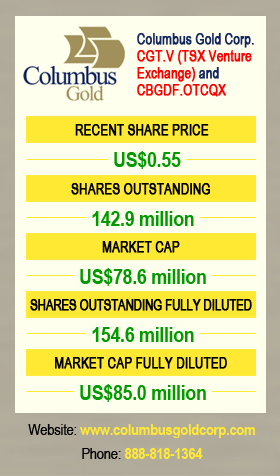 The Next Big Junior
The Next Big Junior
Gold Stock Winner
It all adds up to make Columbus one of the most compelling investment stories in the junior sector.
Just a rising gold price alone will send the company’s share price higher.
But add in the expected path of a potential buy-out by Nordgold, and you see the additional potential of an offer at twice or more the company’s market value.
And don’t forget to factor in the possibility that further drilling by Columbus and/or Nordgold will grow the size of Montagne d’Or.
Then you add in the possibility of a bidding war for the entire company…
…Plus the potential for a big upside surprise on the resource at the Eastside project…
…And the possibility of that project being spun out into a new “bonus” company for shareholders…
…And you get what may be the most exciting junior gold investment in this market.
The bottom line: Make sure you have a position in Columbus Gold before any of these happy events can come together.

